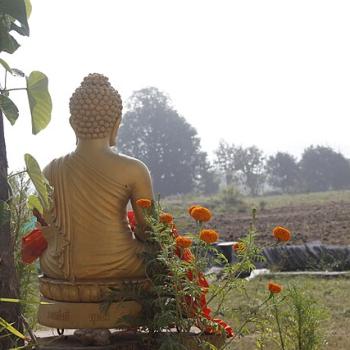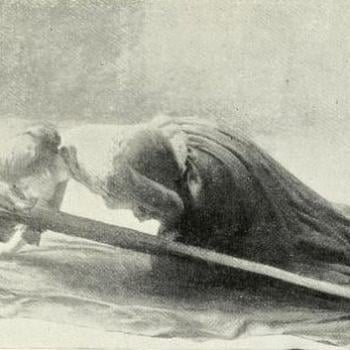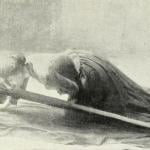GREAT TRANSFORMATIONS
Of Axial Ages and the Transformative Possibility of the Human Imagination
A Sermon
31 January 2010
James Ishmael Ford
First Unitarian Church
Providence, Rhode Island
Text
The living way is like a well:
You can constantly use it, and yet it never dries up.
It is the eternal boundlessness;
Birthing the infinite worlds.
It is hidden from sight and yet always present.
I have no idea who gave it birth.
It is older than God.
Tao Te Ching, Chapter 4
(version adapted by the author from various translations)
Somewhere close to a million years ago, well, according to the calendar somewhere on the cusp between the nineteen sixties and seventies, my girlfriend and I attended the San Francisco production of Hair. We were the people the show was about. Which, among other things, also meant we didn’t have a lot of disposable income. I worked in a bookstore while my girlfriend had a sequence of jobs, few lasting more than a couple of months. And, therefore, I’d never been to a Broadway road show before. So this was a big deal.
It was a treat and a half. As you may know the actors would burst through the “fourth wall,” interacting with the audience. At one point a muscular guy lacking a shirt did a shimmy right up in front of my girlfriend. She was embarrassed and delighted. I recall him wrapping a cheap boa around her neck, which she was able to return home with, and kept for several years. For all I know she still has it.
For me, the major importance of that production was how it told me that this whole strange thing going on in the Bay Area was actually much bigger than I’d been aware of. I knew it had power. I knew it had something to do with liberation. But this bit of Broadway showed the epochal nature of what was going on. Or, at least the hope for it being such. Now a lifetime has passed and I still find the lyrics to “Age of Aquarius” popping into my head at the most unexpected times.
Seeing that show set me to thinking about what I was doing in my life. I’d had a Zen practice for a couple of years. But inspired, and challenged, and believing maybe there were deeper possibilities yet, this was one of several events that pushed me to a next level, leading me to enter a Zen monastery on a quest for my own deeper experience of some Age of Aquarius.
A decade or so later I read Gore Vidal’s novel Creation. And I had a similar wave of feeling at least in the sense his novel was holding some of that same sense of epochal change, similar in some visceral way to my own leap into a new life. Creation, if you don’t know, opens with an aged Persian ambassador to Athens incensed as he hears Herodotus lecture on the Persian wars and decide to provide his own reminiscences of recent history, much of which he witnessed at first hand.
The putative author of these memoirs is the grandson of the prophet Zoroaster. Thanks to this privileged condition, he found himself everywhere that counted in this amazing age, an epochal age that showed my Age of Aquarius to be a mere mind bubble. From when the story begins where he watches his young stonemason Socrates building a wall that keeps falling down, back to his time with the Buddha who would look right through him when they were talking, always preferring to gaze into the middle distance over making eye contact, to his time with what is obviously Vidal’s favorite character, Confucius. But as this is Vidal even this hero of mind and spirit has a face like a horse and a bad case of halitosis. That’s pure Gore Vidal, history as gossip.
This book is Vidal’s treatment of the Axial Age. That term, Axial Age comes from the philosopher Karl Jaspers’ 1949 study, Origin and Goal of History. Most of us, if we’ve heard the term Axial Age, can actually thank the independent scholar Karen Armstrong who made much of it in her History of God and then went on to a detailed reflection in the Great Transformation. It is Jasper’s, Armstrong’s, and truthfully, many scholars and philosophers and theologians view that there was a period roughly between the eighth and second centuries before our common era, where the world changed.
In a time of darkness and violence at various places around the globe ranging from the Greek philosophers of the Mediterranean basin, into the Near East were various prophets began to proclaim visions of justice, to India where Mahavira and Gautama Siddhartha taught and to China where Confucius and Laotzu proclaimed new visions of life, what would become the world religions, or at least their ancestors most all emerged.
Armstrong presents a fascinating thesis. She says an ethical spirituality emerged in this Age. Articulated in many different ways, nonetheless containing some tangible commonalities. Among the most important was that summation of morality first articulated by the guy with bad breath, writing five hundred years before the birth of Jesus, ‘Do not do unto others as you would not have them do unto you.’ In Great Transformation Armstrong elaborates on her vision of that common thread she perceives, a sort of ethical mysticism.
Now, I like Karen Armstrong. Maybe not as much as Gore Vidal, it has been pointed out I tend to like the sour guys, at least if they’re witty. But, obviously, Armstrong is a more important thinker. I really like her ethical mystical vision. And I recommend Great Transformation. It speaks of a way of living in the world that is quite inviting, highly compatible with our own contemporary sense of liberal religion.
That said there are real problems with this whole thesis of the Axial Age, which is seen as a profound advancement, an evolutionary leap over what was before. I feel some hesitation about how we know this. The textual data about what was going on before isn’t particularly helpful. Mostly we get details of sacrificial practices, from which we derive a lot of suppositions, but little certainty about what they actually thought and felt. Although one thing we do get is that those so-called primal religions that in much of the world would soon be swept away tended to be pretty tolerant of each other.
Which just isn’t true for the Near Eastern religions such as Zoroastrianism, or the proto-religion, which would over time birth Judaism, Christianity and Islam. These were all religions that were pretty adamant they had a finger on the one true way, and so the adherents of these religions, as we know, have not tended to play well with others. That and the holding up of images of war and violence as sacred have had dire consequences for many people. There’s been lots of blood flowing from that particular Axial Age thesis, lots. And frankly not something I see as an advancement of the human condition.
The second difficulty is working up a realistic timeline. This whole Axial Age is one slippery concept. Christianity actually births two hundred years after most scholars would end the period, and Islam nearly seven centuries after that. With over three and a half billion adherents between them, that’s over half of humanity not actually heirs to this era. In addition contemporary scholarship seems to relentlessly push the life of the prophet Zoroaster ever earlier than had originally been thought. And Laotzu, if there ever was a Laotzu, I mean how many people name their child “old man,” turns out not to be a contemporary of Confucius, but a much later figure.
Vidal can get away with his timeline, he’s just writing a novel. But for a historical philosophical investigation, well, it’s stuck with the moving and mutable target called history. And history isn’t particularly kind to the idea of an Axial Age. There’s something there, but how much is very much an open question.
But, most important, much is made of the assertion that in this Axial Age, there was a shift in perspective from a collective consciousness to a realization of the importance of the individual. This is my third concern, and what I really want to pull out and to look at very closely. This means we need to try and untangle the human being from culture, look at the wiggly monster, then, hopefully without too much damage, put it back in. With my personal goal of suggesting in that process what it might be that we’re about here in this Meeting House.
Now for this thesis to be true would mean an evolutionary shift in human consciousness that took place within the bounds of recorded history. And I consider this bogus. The shape of the human mind finds its origins much, much earlier. The little bands Anthropologists call Homo sapiens sapiens who arose in Africa and some of whom left to populate much of the world, were long before the rise of the Axial Age cultures fully human. And by definition, these humans were fully capable of knowing their individuality as well as their radical dependence upon each other.
And at the same time we’re creatures of culture. We live and breathe and take our being within our cultures. We’re dependent upon our cultures in ways we almost never know. They protect us, and in some ways, they imprison us. And cultures change, one emphasizing say the communal, another, say the individual, then a shift. A shift like that in the Axial Age can be true, but a grander claim, I don’t think so.
Although, and this is equally important, equally central to what I want to hold up for us here: we’re always, I deeply believe, always capable of waking up out of our culture and seeing ourselves in a much bigger way. This is some magical truth, which I’m positive has been inherent in us from the birth of that first ancestor who fits the bill we call Homo sapiens sapiens. Yes, maybe even earlier, but for sure at that moment with the birth of our true Eve, our first true Adam.
As to cultural shifts, I remember the enormous popularity about twenty years ago of the idea of “paradigm shifts.” Perhaps you remember? The term “paradigm shift” was, I think, coined by Thomas Kuhn in his study, The Structure of Scientific Revolutions. While some saw these changes as just changes, Kuhn saw the term paradigm shift as descriptive of changing scientific worldviews, in a more or less evolutionary way of advancement, with one view displacing another.
But the term quickly got away from him. I recall consultants who advertised their abilities to burst people’s perspectives through their trademarked paradigm shift programs. I recall talking with people who spoke of changing their mind about something like their preference in sandwiches as a paradigm shift. The term quickly became faddish, silly, and in a heartbeat, passé.
I think there’s something similarly oversimplified and faddish in the idea of the Axial Age. Particularly as its foremost advocate, Karen Armstrong also posits a second Age, which she locates as beginning in the sixteenth century. So, she too, is positing moments in time and culture where things change. And we can run with that. And we do.
A few describe this emergent worldview as “objective.” Whether this is supposed to be the final flowering of the second Axial Age, or the dawn of a third Age, I’m not so sure. Again, the sense is this is some evolutionary advancement. Again, I find this rather unlikely. I witness my friends on the spiritual path, I look at myself, and I find the old Buddhist story of the blind men and the elephant ever so. The human condition is always to see through a glass darkly, without, however, that later time when all is made clear. We find on this path: in the beginning through a glass darkly, in the middle through a glass darkly, and at the end through a glass darkly.
Which, again, brings us back to this Meeting House, and our lives, within this culture. And who we are, and who we might be. My friend Ellen Skagerberg observed how “We want our own ephemeral selves to be central to history, so we want ours to be an axial age also.” I find this a serious challenge, and, within it, perhaps an invitation.
Now one of the things I really like about Vidal’s Axial Age is that he distrusts the documents, and points out how winners are rewriting the official histories all the time. His cynicism drips from every page. And I think Vidal goes too far. We need a critical heart, not a sour one. And, I think Ellen gives us both a warning and an invitation.
Just as we UUs take our ancestral Christian holidays, Christmas and Easter and reframe each to our own purposes, Christmas to the hope birthing with each child and Easter as the endless possibilities of new birth that comes with each season, we can look at the possibilities of an Axial Age for each of us. It is both the smallest of things, and can be the greatest. We always sit at the edge. Always. Between what was and what will be.
We, I at least, want to be at the Axial Age. I wanted the Age of Aquarius to be the Axial Age. But, that’s too grand, too big. And if I cling to that, I miss an opportunity for my own life. There is a corollary, where we think nothing of our lives, pay no attention, and care not a whit, or just don’t believe our lives matter that much. Both are mistakes. Both miss the lessons that are always presenting.
But. If I get a little modest, if another dares to think maybe their life counts, we can open ourselves to something wondrous. The Persian ambassador, the grandson of the prophet, he’s an observer, he sees. Maybe an encounter with our own lives as a bit of gossip, something for us to look at, each of us, with a little amusement, can be a good thing.
So, here’s that “but.” But something else is going on, as well. Each moment is epochal. Get the ego out of the way, a little bit, just a little bit, and the majesty of what is presents. What was passes away. What is to be is birthing. And, and this is the most important part. We, each of us, you and I, we have a hand in it.
Our choices count. What we do shapes our lives and history itself.
So, watch out, what you do can birth an Epoch, can create an Axial Age, might even bring about the Age of Aquarius.
Be careful. And, good luck.
Amen.
http://www.youtube.com/watch?v=LANwIgpha7k












